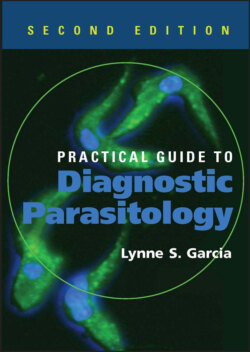Читать книгу Practical Guide to Diagnostic Parasitology - Lynne Shore Garcia - Страница 43
На сайте Литреса книга снята с продажи.
Request for Blood Films
ОглавлениеMalaria is one of the few parasitic infections considered to be immediately life-threatening, and a patient with the diagnosis of P. falciparum malaria should be considered a medical emergency because the disease can be rapidly fatal. Any laboratory providing the expertise to identify malarial parasites should do so on a STAT basis (24 h/day, 7 days/week).
Patients with malaria can present for diagnostic blood work when they are least expected. Laboratory personnel and clinicians should be aware of the STAT nature of such requests and the importance of obtaining some specific patient history information. On microscopic examination of the blood films, the typical textbook presentation of various Plasmodium morphologies may not be seen by the technologist. The smears should be examined at length and under oil immersion. The most important thing to remember is that even though a low parasitemia may be present on the blood smears, the patient may still be faced with a serious, life-threatening disease.
It is important for both physicians and laboratorians within areas where malaria is not endemic to be aware of the problems associated with malarial diagnosis and to remember that symptoms are often nonspecific and may mimic other medical conditions. Physicians must recognize that travelers are susceptible to malarial infection when they visit a country where malaria is endemic, and that they should receive prophylactic medication.
With the tremendous increase in the number of people traveling from the tropics to malaria-free areas, the number of imported malaria cases is also on the rise. There have been reports of imported infected mosquitoes transmitting the infection among people who live or work near international airports. It is also possible that mosquitoes can reach areas far removed from the airports. This situation has been termed “airport malaria,” malaria that is acquired through the bite of an infected anopheline mosquito by persons with apparently no risk factors for the disease. Unfortunately, unless a careful history is obtained, the diagnosis of malaria can be missed or delayed. Tests to exclude malaria should be considered for patients who work or live near an international airport and who present with an acute febrile illness. The potential danger of disseminating the mosquito vectors of malaria via aircraft is well recognized; however, modern disinfection procedures have not yet eliminated the risk of vector transportation. Not only can insects survive nonpressurized air travel, but also they may be transported further by car or other means after arriving at the airport.
We usually associate malaria with patients having a history of travel within an area where malaria is endemic. However, other situations that may result in infection involve the receipt of blood transfusions, use of hypodermic needles contaminated by prior use (for example, by drug addicts), possibly congenital infection, and transmission within the United States by indigenous mosquitoes that acquired the parasites from imported infections.
Malaria is usually associated with patients having a history of travel within an area where malaria is endemic, although other routes of infection are well documented. Frequently, for a number of different reasons, organism recovery and subsequent identification are more difficult than the textbooks imply. It is very important that this fact be recognized, particularly when one is dealing with a possibly fatal infection with P. falciparum. It is important to ensure that clinicians are familiar with the following issues.
